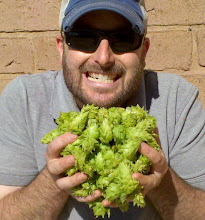This is my classic Blueberry Wheat. Very simple recipe and a huge crowd pleaser. I've tried a few other fruity combinations but this is the true winner. It is requested every year for our New Year's Bash up in Big Bear and certainly fuels our annual Winter Games.
 |
| Andrew floats blueberries on the top of last year's Blueberry Wheat. |
My underline issue here is consistency. I believe this is the ONLY brew I've ever made more than twice. Getting more than one gravity result (again, 1.050 vs. previous batches 1.058-1.060) makes you realize how much each beer brewed depends on the execution of a specific process. Also, you have to accept that ingredients may also change, even year to year. On my equipment, I know there's a great deal of human variability (another argument to get a brew sculpture with more control over the process, any sponsors?). While a change in ingredients is the first major variable, I decided to reduce my mash time to 60 minutes from a suggestion by Harold during a beer evaluation session. While the evaluation committee didn't evaluate this particular beer, Harold discussed the importance of not extending the mash time to 90 minutes.
Why change a thing that's worked really well in the past? Well, I can't tell what affected my gravity target: malt or a change in mash times. Of course, there can be other variables in play that are not quite as obvious. Many of us homebrewers evolve our process over time. I am likely not the same brewer I was when this beer was last made.
So here's the big question: 60 minute single infusion or 90 minutes? I've previously heard and read that 90 minutes is essential to ensure a full conversion and others have been convincing that time beyond 60 minutes can break down essential final products (don't remember their specifics here). In a month, I'll have the verdict whether or not this basic grain bill has an improved flavor and body profile at the expense of potential alcohol. I would be interested in doing a full experiment but that's hard to do without good controls (again, any takers?). I doubt the guy below has an answer, anyone else?
 |
| Saw this guy in SF. He's got it wrong, should read, "Why lie, I need a homebrew". |
BJCP Category 20. Fruit Beet
5 Gallons, All Grain, Single Infusion Mash, 90 Minute Boil
7 lbs. Red Wheat
4 lbs. Domestic 2-Row
Single Infusion Mash
(1 qt./lb. raised to 167°F)
Saccharification Rest at 148°F for 70 minutes
Fly-sparged 5.5 gallons at 170°F
1 oz. Hallertauer 60 min.
White Labs WLP001 California Ale Yeast 2 vials (thanks Kara)
2 oz. Blueberry Flavoring added at kegging
OG: 1.050 @ 68°F
FG: 1.006 @ 66°F
ABV: 5.9%






No comments:
Post a Comment
Make a comment already. While waiting for your comment to be moderated, have a homebrew!